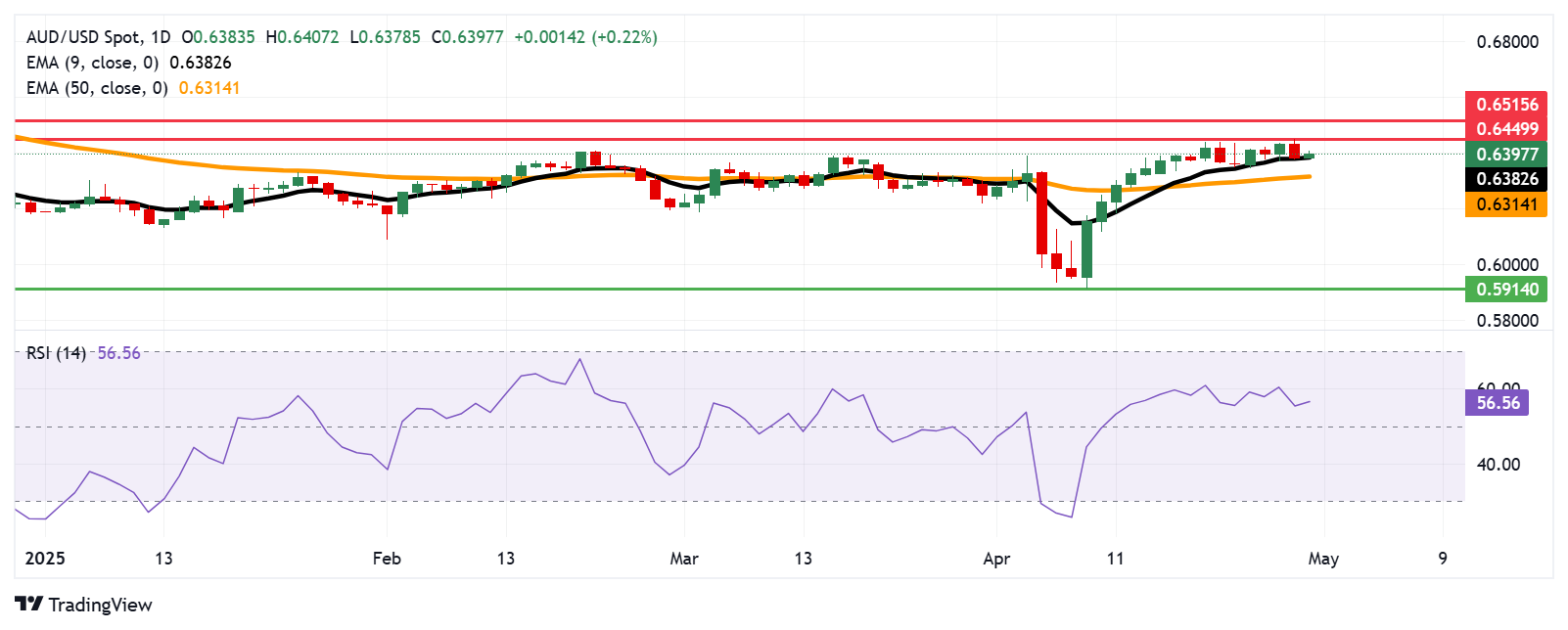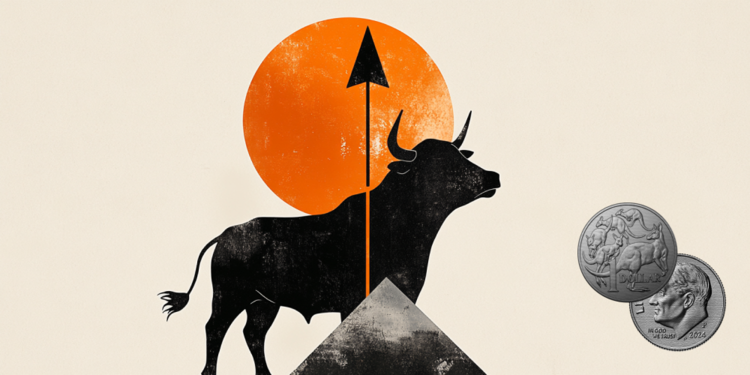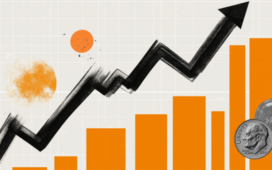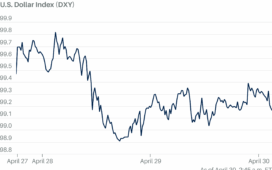- The Australian Dollar is regaining ground after the release of key economic data from both Australia and China.
- Australia’s Consumer Price Index rose 0.9% QoQ in Q1, up from a 0.2% previous increase and a 0.8% expected rise.
- China’s NBS Manufacturing PMI dropped to 49.0 in April from 50.5 in March, returning to contraction in the sector.
The Australian Dollar (AUD) is gaining ground on Wednesday following a more than 0.50% decline against the US Dollar (USD) in the previous session. The AUD/USD pair appreciates following the release of key economic data from Australia and China.
The Australian Bureau of Statistics (ABS) reported that the Consumer Price Index (CPI) rose by 0.9% quarter-over-quarter in Q1 2025, up from a 0.2% increase in Q4 2024 and exceeding market expectations of a 0.8% rise. On an annual basis, CPI climbed 2.4% in the first quarter, beating the forecast of 2.2%.
Australia’s Monthly CPI held steady with a 2.4% year-over-year increase in March. Meanwhile, the Reserve Bank of Australia’s (RBA) Trimmed Mean CPI rose 2.9% year-over-year in Q1, in line with expectations, while the quarterly figure also met forecasts at 0.7%.
In China, the National Bureau of Statistics (NBS) reported that the Manufacturing Purchasing Managers’ Index (PMI) slipped to 49.0 in April from 50.5 in March, falling short of the 49.9 consensus and indicating a return to contraction. The Non-Manufacturing PMI also softened, easing to 50.4 in April from 50.8 in March, below the expected 50.7.
The AUD faces headwinds amid ongoing global trade uncertainties that continue to dampen investor sentiment. Meanwhile, inflationary pressures in Australia in early 2025 have weakened expectations of further monetary easing by the Reserve Bank of Australia (RBA). Markets widely anticipate a 25-basis-point rate cut in May, as policymakers prepare for possible economic fallout from the recently introduced US tariffs.
Australian Dollar recovers ground as confidence in American assets weakens
- The US Dollar Index (DXY), which measures the USD against six major currencies, is maintaining its position above the 99.00 level at the time of writing. Attention now turns to the US Personal Consumption Expenditures (PCE) Price Index report for March, due later on Wednesday.
- On Tuesday, the US Bureau of Labor Statistics reported that Job Openings and Labor Turnover Survey (JOLTS) openings dropped to 7.19 million in March, down from a revised 7.48 million in February and below the market forecast of 7.5 million. This marks the lowest level since September 2024, reflecting softening labor demand amid growing economic uncertainty in the United States (US).
- US President Donald Trump signaled openness to reducing Chinese tariffs, while Beijing exempted certain US goods from its 125% levies. This move has fueled hopes that the prolonged trade war between the world’s two largest economies might be drawing to a close.
- President Trump said that there has been progress, and he has talked with China’s President Xi Jinping. However, a Chinese embassy spokesperson on Friday firmly denied any current negotiations with the US, stating, “China and the US are not having any consultation or negotiation on tariffs.” The spokesperson urged Washington to “stop creating confusion.”
- According to the Wall Street Journal, President Trump intends to lessen the impact of his automotive tariffs by ensuring that duties on foreign-made cars do not stack with other tariffs and by reducing levies on foreign parts used in car production.
- US Treasury Secretary Scott Bessent said on Monday that he interacted with Chinese authorities last week but did not mention tariffs. Bessent stated that while the US government is in communication with China, it is up to Beijing to make the first move to ease the tariff dispute, given the trade imbalance between the two countries.
- Chinese Foreign Minister Wang Yi said on Tuesday that making concessions and retreating would only embolden the bully, emphasizing that dialogue is key to resolving differences.
- China’s Finance Ministry stated on Friday that global economic growth remains sluggish, with tariffs and trade wars continuing to undermine economic and financial stability. The ministry urged all parties to enhance the international economic and financial system through stronger multilateral cooperation, per Reuters.
Australian Dollar moves below 0.6400; tests nine-day EMA
The AUD/USD pair is hovering around 0.6390 on Wednesday, with the daily chart reflecting a bullish outlook. The pair continues to trade above the nine-day Exponential Moving Average (EMA), while the 14-day Relative Strength Index (RSI) holds well above the 50 level—both suggesting sustained upward momentum.
On the upside, immediate resistance is seen at the recent four-month high of 0.6449, which was reached on April 29. A decisive break above this level could pave the way for a move toward the five-month high at 0.6515.
The nine-day EMA at 0.6382 appears as the immediate support, followed by the 50-day EMA at 0.6314. A break below these support levels would weaken the bullish structure and may expose the pair to deeper losses, potentially targeting the March 2020 low around 0.5914.
AUD/USD: Daily Chart

Australian Dollar PRICE Today
The table below shows the percentage change of Australian Dollar (AUD) against listed major currencies today. Australian Dollar was the strongest against the Euro.
| USD | EUR | GBP | JPY | CAD | AUD | NZD | CHF | |
|---|---|---|---|---|---|---|---|---|
| USD | 0.24% | 0.12% | 0.07% | 0.06% | -0.22% | 0.01% | 0.03% | |
| EUR | -0.24% | -0.11% | -0.16% | -0.18% | -0.46% | -0.22% | -0.20% | |
| GBP | -0.12% | 0.11% | -0.08% | -0.07% | -0.35% | -0.11% | -0.10% | |
| JPY | -0.07% | 0.16% | 0.08% | -0.02% | -0.29% | 0.00% | -0.02% | |
| CAD | -0.06% | 0.18% | 0.07% | 0.02% | -0.28% | -0.04% | -0.02% | |
| AUD | 0.22% | 0.46% | 0.35% | 0.29% | 0.28% | 0.24% | 0.26% | |
| NZD | -0.01% | 0.22% | 0.11% | -0.00% | 0.04% | -0.24% | 0.02% | |
| CHF | -0.03% | 0.20% | 0.10% | 0.02% | 0.02% | -0.26% | -0.02% |
The heat map shows percentage changes of major currencies against each other. The base currency is picked from the left column, while the quote currency is picked from the top row. For example, if you pick the Australian Dollar from the left column and move along the horizontal line to the US Dollar, the percentage change displayed in the box will represent AUD (base)/USD (quote).
Australian Dollar FAQs
One of the most significant factors for the Australian Dollar (AUD) is the level of interest rates set by the Reserve Bank of Australia (RBA). Because Australia is a resource-rich country another key driver is the price of its biggest export, Iron Ore. The health of the Chinese economy, its largest trading partner, is a factor, as well as inflation in Australia, its growth rate and Trade Balance. Market sentiment – whether investors are taking on more risky assets (risk-on) or seeking safe-havens (risk-off) – is also a factor, with risk-on positive for AUD.
The Reserve Bank of Australia (RBA) influences the Australian Dollar (AUD) by setting the level of interest rates that Australian banks can lend to each other. This influences the level of interest rates in the economy as a whole. The main goal of the RBA is to maintain a stable inflation rate of 2-3% by adjusting interest rates up or down. Relatively high interest rates compared to other major central banks support the AUD, and the opposite for relatively low. The RBA can also use quantitative easing and tightening to influence credit conditions, with the former AUD-negative and the latter AUD-positive.
China is Australia’s largest trading partner so the health of the Chinese economy is a major influence on the value of the Australian Dollar (AUD). When the Chinese economy is doing well it purchases more raw materials, goods and services from Australia, lifting demand for the AUD, and pushing up its value. The opposite is the case when the Chinese economy is not growing as fast as expected. Positive or negative surprises in Chinese growth data, therefore, often have a direct impact on the Australian Dollar and its pairs.
Iron Ore is Australia’s largest export, accounting for $118 billion a year according to data from 2021, with China as its primary destination. The price of Iron Ore, therefore, can be a driver of the Australian Dollar. Generally, if the price of Iron Ore rises, AUD also goes up, as aggregate demand for the currency increases. The opposite is the case if the price of Iron Ore falls. Higher Iron Ore prices also tend to result in a greater likelihood of a positive Trade Balance for Australia, which is also positive of the AUD.
The Trade Balance, which is the difference between what a country earns from its exports versus what it pays for its imports, is another factor that can influence the value of the Australian Dollar. If Australia produces highly sought after exports, then its currency will gain in value purely from the surplus demand created from foreign buyers seeking to purchase its exports versus what it spends to purchase imports. Therefore, a positive net Trade Balance strengthens the AUD, with the opposite effect if the Trade Balance is negative.





